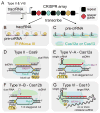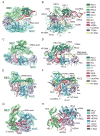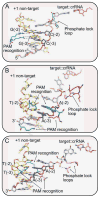The Revolution Continues: Newly Discovered Systems Expand the CRISPR-Cas Toolkit
- PMID: 28985502
- PMCID: PMC5683099
- DOI: 10.1016/j.molcel.2017.09.007
The Revolution Continues: Newly Discovered Systems Expand the CRISPR-Cas Toolkit
Abstract
CRISPR-Cas systems defend prokaryotes against bacteriophages and mobile genetic elements and serve as the basis for revolutionary tools for genetic engineering. Class 2 CRISPR-Cas systems use single Cas endonucleases paired with guide RNAs to cleave complementary nucleic acid targets, enabling programmable sequence-specific targeting with minimal machinery. Recent discoveries of previously unidentified CRISPR-Cas systems have uncovered a deep reservoir of potential biotechnological tools beyond the well-characterized Type II Cas9 systems. Here we review the current mechanistic understanding of newly discovered single-protein Cas endonucleases. Comparison of these Cas effectors reveals substantial mechanistic diversity, underscoring the phylogenetic divergence of related CRISPR-Cas systems. This diversity has enabled further expansion of CRISPR-Cas biotechnological toolkits, with wide-ranging applications from genome editing to diagnostic tools based on various Cas endonuclease activities. These advances highlight the exciting prospects for future tools based on the continually expanding set of CRISPR-Cas systems.
Keywords: C2c1; C2c2; CRISPR-Cas; Cas12; Cas13; Cas9; Cpf1; RNA-guided DNA cleavage; RNA-guided RNA cleavage; genome editing.
Copyright © 2017 Elsevier Inc. All rights reserved.
Figures





Similar articles
-
Inhibition Mechanism of an Anti-CRISPR Suppressor AcrIIA4 Targeting SpyCas9.Mol Cell. 2017 Jul 6;67(1):117-127.e5. doi: 10.1016/j.molcel.2017.05.024. Epub 2017 Jun 9. Mol Cell. 2017. PMID: 28602637 Free PMC article.
-
Structural Basis for Guide RNA Processing and Seed-Dependent DNA Targeting by CRISPR-Cas12a.Mol Cell. 2017 Apr 20;66(2):221-233.e4. doi: 10.1016/j.molcel.2017.03.016. Mol Cell. 2017. PMID: 28431230 Free PMC article.
-
The Anti-CRISPR Story: A Battle for Survival.Mol Cell. 2017 Oct 5;68(1):8-14. doi: 10.1016/j.molcel.2017.09.002. Mol Cell. 2017. PMID: 28985512 Review.
-
Advances in Industrial Biotechnology Using CRISPR-Cas Systems.Trends Biotechnol. 2018 Feb;36(2):134-146. doi: 10.1016/j.tibtech.2017.07.007. Epub 2017 Aug 1. Trends Biotechnol. 2018. PMID: 28778606 Review.
-
CRISPR-Based Technologies: Impact of RNA-Targeting Systems.Mol Cell. 2018 Nov 1;72(3):404-412. doi: 10.1016/j.molcel.2018.09.018. Mol Cell. 2018. PMID: 30388409 Free PMC article. Review.
Cited by
-
CRISPR/Cas-Based Biosensor As a New Age Detection Method for Pathogenic Bacteria.ACS Omega. 2022 Oct 18;7(44):39562-39573. doi: 10.1021/acsomega.2c04513. eCollection 2022 Nov 8. ACS Omega. 2022. PMID: 36385843 Free PMC article. Review.
-
Identification of Family-Specific Features in Cas9 and Cas12 Proteins: A Machine Learning Approach Using Complete Protein Feature Spectrum.bioRxiv [Preprint]. 2024 Jan 23:2024.01.22.576286. doi: 10.1101/2024.01.22.576286. bioRxiv. 2024. Update in: J Chem Inf Model. 2024 Jun 24;64(12):4897-4911. doi: 10.1021/acs.jcim.4c00625. PMID: 38328240 Free PMC article. Updated. Preprint.
-
CRISPR-Cas12a exhibits metal-dependent specificity switching.Nucleic Acids Res. 2024 Sep 9;52(16):9343-9359. doi: 10.1093/nar/gkae613. Nucleic Acids Res. 2024. PMID: 39019776 Free PMC article.
-
Novel genetic therapeutic approaches for modulating the severity of β-thalassemia (Review).Biomed Rep. 2020 Nov;13(5):48. doi: 10.3892/br.2020.1355. Epub 2020 Sep 2. Biomed Rep. 2020. PMID: 32953110 Free PMC article. Review.
-
Potent Cas9 Inhibition in Bacterial and Human Cells by AcrIIC4 and AcrIIC5 Anti-CRISPR Proteins.mBio. 2018 Dec 4;9(6):e02321-18. doi: 10.1128/mBio.02321-18. mBio. 2018. PMID: 30514786 Free PMC article.
References
-
- Abudayyeh OO, Gootenberg JS, Konermann S, Joung J, Slaymaker IM, Cox DBT, Shmakov S, Makarova KS, Semenova E, Minakhin L, Severinov K, Regev A, Lander ES, Koonin EV, Zhang F. C2c2 is a single-component programmable RNA-guided RNA-targeting CRISPR effector. Science. 2016:353. doi: 10.1126/science.aaf5573. - DOI - PMC - PubMed
Publication types
MeSH terms
Substances
Grants and funding
LinkOut - more resources
Full Text Sources
Other Literature Sources

